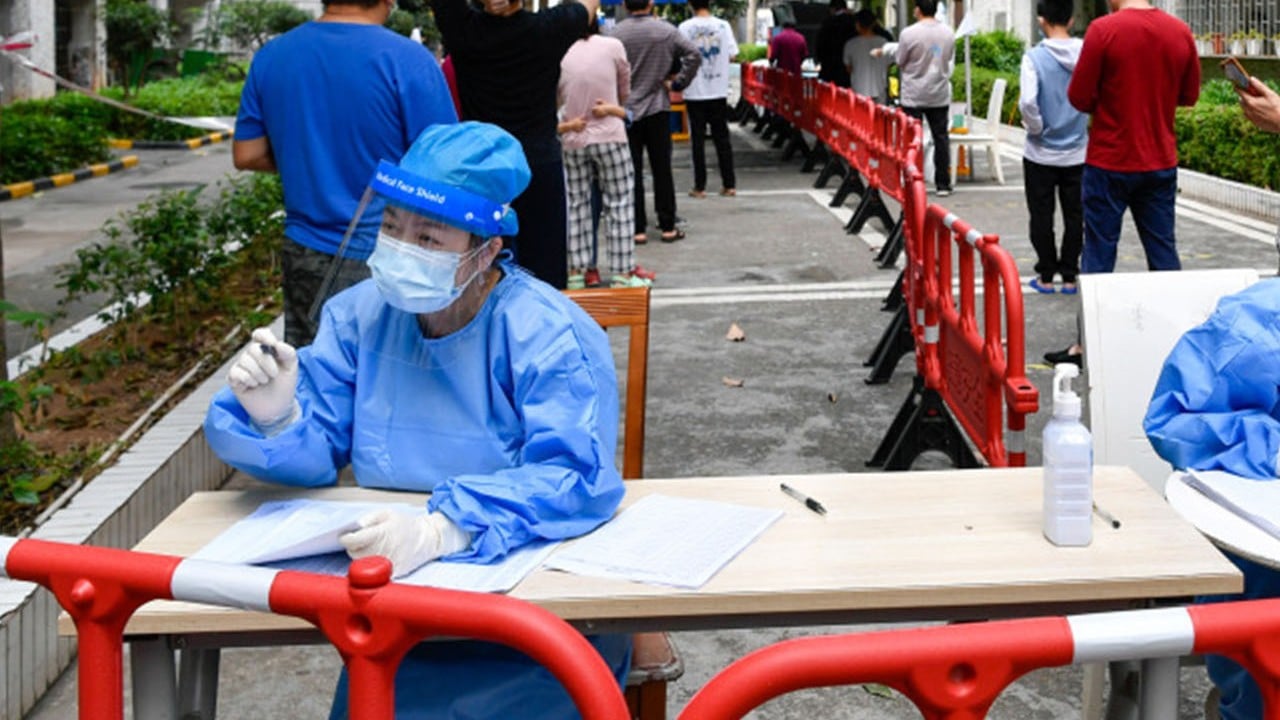
China’s big city plan for Covid testing just a 15-minute walk away
- Vice-Premier Sun Chunlan says testing booths will be within easy reach for all residents in the country’s major cities
- The strategy was first used in economic and tech hub Shenzhen, which controlled an outbreak in March with one week of lockdown
China pledges ‘strictest, most resolute’ measures to halt Omicron spread
According to state news agency Xinhua, Sun told the cabinet the government should rally behind President Xi Jinping’s edict by “unswervingly enforcing the dynamic zero policy … to make sure the outbreaks are manageable and to create a favourable environment for a successful 20th party congress”.
Other measures include the building of more makeshift hospitals and quarantine facilities, which can be ready within 24 hours as needed, and stepping up vaccinations for the elderly.
Shenzhen, in the southern province of Guangdong, was the first city to set up testing booths within the newly mandated 15-minute walking distance. The economic and tech hub started building nucleic testing sites when it reported a couple of dozen new daily cases in mid-March.
The booths – located in residential areas, inside the CBD, industrial and hi-tech parks, as well as outdoor public facilities such as parks and stadiums – operate at lunchtime and after working hours to encourage office workers to get tested.
The city managed to avoid a massive outbreak of the more transmissible Omicron variant, bringing infections under control after a week of lockdown.
China began introducing compulsory regular PCR testing as a requirement for work, school and entry to all public venues after the Shanghai outbreak – still not contained after more than a month of lockdowns and large numbers of people in quarantine.
Beijing, for example, introduced a requirement for its residents to produce negative PCR tests every seven days after the Labour Day holiday.
Also this month, Shanghai and Jiangsu, the neighbouring coastal province north of the city, deployed PCR testing vehicles in addition to booths to make sure residents could walk to a facility within 15 minutes.
In Shanghai’s Hongkou district, one of the city’s worst-hit areas, 120 booths are planned.
The booths are usually sealed, with gloved healthcare workers taking the swabs through holes in the window. The public queues up for testing outdoors as the authorities try to reduce the chance of transmission.
But the increase in testing facilities also means that residents in all China’s large cities will have to line up every week – or even every few days – to take part in normal daily activities.
Liu Liu, who works at a robotics company in Shenzhen, said he takes a test every two or three days, usually after work at one of the two booths in front of his residential compound, which are open from 9am to 10pm.
Liu, who is required to show a negative result within the previous 72 hours before he can enter his office building, said the process usually takes about 10 minutes. There are a few testing stations near his workplace, but the queues there are too long.
“It’s time consuming and stressful for the medical staff, but not too much trouble for us,” he said. “We have accepted the fact it’s gradually becoming part of our daily lives.”
In Beijing’s Haidian district, Luo Bing said long queues made testing inconvenient, even though it is free, and it was difficult for her daughter to get tested between online lessons.
“We need to run to testing sites nearby during the noon break, but there is always a long line because all other students are thinking the same,” said Luo, a 40-year-old office worker.
Chinese tourism turns inward amid strict zero-Covid policies
“It’s always like a race to have lunch quickly and get a spot in the testing line. We have to do it because schools request us to report we have done the testing, even though they are not in-person teaching.”
Luo said the queues are so common that whenever she sees a short one she feels she should get tested, to renew her negative result. “The testing has done something to my mind,” she said.
Some people are worried they will get infected during the testing process. Many Shanghai residents believe the high numbers of local cases have persisted, despite weeks of lockdown, because the virus spread among those queuing for tests.
Why Shanghai’s Covid crisis could have wider implications
In Beijing, Jessica Song who lives in Dongcheng district, said she is always careful when queuing for tests for fear she might get infected in the crowd.
“I order groceries online and have been working at home, so my biggest worry of getting infected is when queuing for testing. I keep a distance from others and try not to touch anything on the table, and only pull off my mask when the testing staff take out the swab. [Then I] immediately put my mask back on,” she said.
“I heard some people became infected after the whole residential area had been negative for days and the only thing they did was go out for testing. It will be really unlucky if it happens to anyone, to be infected when testing.”
In the early days of the pandemic, countries like South Korea strengthened their testing capability with drive-through test stations.
However, the emergence of the more transmissible and milder Omicron strain, combined with the availability of rapid antigen tests, has led most countries to accept negative results as a condition for people to resume activities like work and school.
Many countries have also abandoned testing requirements all together, because of Omicron’s mild effects compared to earlier variants.
Where they are still used in Western countries, nucleic tests are a diagnostic, rather than a mass-screening tool.
China began allowing its residents to buy rapid tests as a supplementary tool from mid-March, but still insists on using centralised nucleic testing as a way to identify every single infection.


.jpg?itok=H5_PTCSf&v=1700020945)


